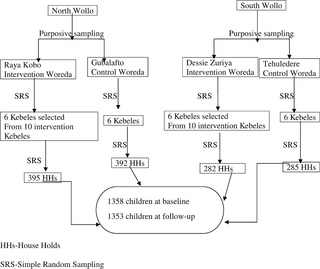PLOS Neglected Tropical Diseases ( IF 3.4 ) Pub Date : 2017-11-10 , DOI: 10.1371/journal.pntd.0006080 Beselam Tadesse , Alemayehu Worku , Abera Kumie , Solomon Abebe Yimer

|
Background
Trachoma is chronic kerato conjunctivitis, which is caused by repeated infection with Chlamydia trachomatis bacterium. It is hyper endemic in many rural areas of Ethiopia. The objective of this study was to measure the effect of water, sanitation and hygiene interventions on active trachoma in selected woredas of North and South Wollo zones of Amhara Region, Ethiopia.
Methodology
A community based quasi-experimental study was conducted from October 2014 to December 2015 among children aged 1–8 years at baseline and among one year older same children after intervention. A four-stage random cluster-sampling technique was employed to select study participants. From each selected household, one child was clinically assessed for active trachoma. Structured questionnaire was used to collect socio demographic and behavioral data. MacNemar test was applied to compare the prevalence of active trachoma between baseline and after the intervention period at both intervention and non-intervention study areas.
Results
The prevalence of active trachoma was reduced from baseline prevalence of 26% to 18% after one-year intervention period in the intervention woredas (P≤0.001). MacNemar test result showed significant reduction of active trachoma prevalence after the intervention period in the intervention woredas compared to the non-intervention woredas (P≤0.001). Water, sanitation and hygiene related activities were significantly improved after the intervention period in the intervention woredas (P<0.05).
Conclusions
There was a significant reduction of active trachoma prevalence between the baseline and after the intervention period in the intervention woredas, but not in the non-intervention ones. Improved water, sanitation and hygiene interventions contributed to the reduction of active trachoma. However, the magnitude of active trachoma prevalence observed after the intervention is still very high in the studied areas of North and South Wollo Zones communities. To achieve the global trachoma elimination target by the year 2020 as set by the WHO, continued WaSH interventions and periodic monitoring, evaluation and reporting of the impact of WaSH on active trachoma is warranted.
中文翻译:

水,卫生和卫生干预措施对埃塞俄比亚阿姆哈拉地区北部和南部沃尔洛地区活动性沙眼的影响:一项准实验研究
背景
沙眼是慢性角膜结膜炎,由反复感染沙眼衣原体细菌引起。在埃塞俄比亚的许多农村地区,它是地方性流行病。这项研究的目的是测量水,卫生和卫生干预措施对埃塞俄比亚阿姆哈拉地区北部和南部Wollo地区某些woredas地区活动沙眼的影响。
方法
2014年10月至2015年12月,对基线为1-8岁的儿童和干预后的1岁以上同龄儿童进行了基于社区的准实验研究。采用四阶段随机聚类抽样技术选择研究参与者。从每个选定的家庭中,对一名儿童进行了活动性沙眼的临床评估。结构化问卷用于收集社会人口统计学和行为数据。在干预和非干预研究区域,应用MacNemar测试来比较基线和干预期后活动性沙眼的患病率。
结果
活性沙眼患病率在干预瓦雷达斯(一年干预期后从26%患病率基线降低到18%P ≤0.001)。MacNemar测试结果显示,与非干预性干预相比,干预性干预后的活动期沙眼活动率明显降低(P≤0.001)。干预后干预后,与水,卫生和卫生有关的活动明显改善(P <0.05)。
结论
在基线期和干预期之后,在活动性沙眼中活动性沙眼患病率显着降低,但在非干预性沙眼中则没有。改善水,环境卫生和个人卫生干预措施有助于减少活动性沙眼。但是,在北部和南部Wollo Zones社区的研究区域中,干预后观察到的活动性沙眼患病率仍然很高。为了达到世界卫生组织设定的到2020年消除沙眼的全球目标,有必要继续进行WaSH干预,并定期监测,评估和报告WaSH对活动性沙眼的影响。











































 京公网安备 11010802027423号
京公网安备 11010802027423号